Spain has taken great strides to become a center of gastronomy over the past decade. More than a few of the country’s eating establishments have risen to become some of the world’s most famous restaurants, including El Bulli, which I’ve mentioned on previous occasions.
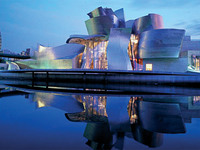 Some of these restaurants serve surprising and extraordinary dishes, while others offer more typical Spanish fare. Still, others might serve just Catalan or classic Basque dishes. Both of these regions are located not far from France: From El Bulli in Catalonia in the northeast of Spain, it’s just a 30-minute drive to France. Likewise, from San Sebastian in the Basque Country in the country’s north, it’s just a half-hour drive to the French border. But while you might think that you see French traces in Spanish cuisine, you would be wrong, especially in the case of Catalan cuisine, which has no French traces. In San Sebastian, I stayed in the Maria Christina Hotel – a place I highly recommend. It’s in the perfect location for guests who want to walk or swim. The only drawback? It only has a subpar Chinese restaurant (given the plethora of Michelin starred restaurants in the vicinity, I assume they wanted to create an alternative). Still, the breakfast is nice. Sporting a classical interior design, the Marina Christina is located in an old building, although it has been newly refurbished and restored. I stayed in Bilbao just one night, but I did not like my hotel, so if you come across any possibility, please do keep me informed. That aside, the Guggenheim Museum in Bilbao is a magnificent place; if anything, the exterior is even more breathtaking than the artwork inside. The museum is almost worth extending your trip to see. Because some high-end restaurants are often closed on Mondays, if not Sundays, I specifically chose Friday and Saturday to visit, although some places are open on Sundays for lunch. Now, in an effort to eat everywhere, you may think you can visit up to five or six restaurants in just two days by just eating light, but you really can’t: Sometimes it takes three or more hours to actually try a restaurant’s menu. That’s why it’s better to just go for a light lunch and then try the menus for dinner so that you get the full experience of the restaurant – even if that means trying fewer establishments.
Some of these restaurants serve surprising and extraordinary dishes, while others offer more typical Spanish fare. Still, others might serve just Catalan or classic Basque dishes. Both of these regions are located not far from France: From El Bulli in Catalonia in the northeast of Spain, it’s just a 30-minute drive to France. Likewise, from San Sebastian in the Basque Country in the country’s north, it’s just a half-hour drive to the French border. But while you might think that you see French traces in Spanish cuisine, you would be wrong, especially in the case of Catalan cuisine, which has no French traces. In San Sebastian, I stayed in the Maria Christina Hotel – a place I highly recommend. It’s in the perfect location for guests who want to walk or swim. The only drawback? It only has a subpar Chinese restaurant (given the plethora of Michelin starred restaurants in the vicinity, I assume they wanted to create an alternative). Still, the breakfast is nice. Sporting a classical interior design, the Marina Christina is located in an old building, although it has been newly refurbished and restored. I stayed in Bilbao just one night, but I did not like my hotel, so if you come across any possibility, please do keep me informed. That aside, the Guggenheim Museum in Bilbao is a magnificent place; if anything, the exterior is even more breathtaking than the artwork inside. The museum is almost worth extending your trip to see. Because some high-end restaurants are often closed on Mondays, if not Sundays, I specifically chose Friday and Saturday to visit, although some places are open on Sundays for lunch. Now, in an effort to eat everywhere, you may think you can visit up to five or six restaurants in just two days by just eating light, but you really can’t: Sometimes it takes three or more hours to actually try a restaurant’s menu. That’s why it’s better to just go for a light lunch and then try the menus for dinner so that you get the full experience of the restaurant – even if that means trying fewer establishments.
San Sebastian has three three-star restaurants, as well as some two-star restaurants. In fact, there was one two-star restaurant I really wanted to visit, but the lack of time put paid to that, so it’s on the list for next summer. But at the risk of raising your ire, I’m not going to mention the best restaurant in San Sebastian. That’s because I want people who visit these restaurants to make their own lists. So let me share my opinions about four of the city’s restaurants and then let me know based on your own opinions; that’ll allow us to compare! San Sebastian gets more than its share of rain, so it’s a very verdant place. That said, it’s best to go when it’s drier, so aim to head there between May and October. Be warned, however, that Europeans generally take their holiday in August, so the city might be very crowded at that time. Meanwhile, San Sebastian’s beautiful coasts are great for a beach holiday. And it would be remiss of me not to mention Biarritz, a favorite holiday destination in the French Basque Country that is just 30 minutes away. But despite the proximity, you can see that there is a distinctive cultural diversity between the two. All these restaurants are quite expensive; the cost depends on your choice of drinks. As a rule of thumb, you’re likely to pay 200 euros per person, excluding alcohol. And to ensure you get maximum enjoyment, it’s best to go to these places by taxi; that way, you don’t have to worry about parking or driving under the influence.
AKELARRE
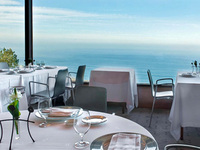
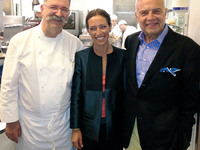 Let’s get our San Sebastian tour underway at Akelarre, which is about 15 minutes out of town. Located on a hill that gives it a panoramic view of the ocean (so it’s the place to be to watch the sunset and the full moon), this modern restaurant has seating for 50-55 people. Akelarre takes its first reservations for 8 p.m. Akelarre’s chef is Pedro Subijana, while his 35-year-old daughter also works as a manager at the restaurant. Akelarre is closed in February and in the first half of October. During the week, it is also closed on Sunday evenings and Mondays. It is possible to eat à la carte, while it also has a few gastronomical menus – the latter of which might be a good idea if you want to try more than one dish. What’s more, they can change some of the food on the gastronomical menu if there’s anything you don’t like. Akelarre serves a lot of Spanish wines, although not a lot of foreign brands. And you should especially make your way to Akelarre by taxi, as the road is windy and unlit – two things that don’t mix well if you’ve had a drink.
Let’s get our San Sebastian tour underway at Akelarre, which is about 15 minutes out of town. Located on a hill that gives it a panoramic view of the ocean (so it’s the place to be to watch the sunset and the full moon), this modern restaurant has seating for 50-55 people. Akelarre takes its first reservations for 8 p.m. Akelarre’s chef is Pedro Subijana, while his 35-year-old daughter also works as a manager at the restaurant. Akelarre is closed in February and in the first half of October. During the week, it is also closed on Sunday evenings and Mondays. It is possible to eat à la carte, while it also has a few gastronomical menus – the latter of which might be a good idea if you want to try more than one dish. What’s more, they can change some of the food on the gastronomical menu if there’s anything you don’t like. Akelarre serves a lot of Spanish wines, although not a lot of foreign brands. And you should especially make your way to Akelarre by taxi, as the road is windy and unlit – two things that don’t mix well if you’ve had a drink.
ARZAK
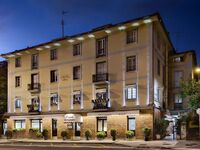
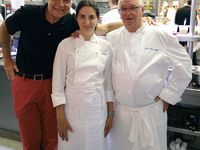 Next on the list is Arzak. Paquita Arzak established the restaurant in the 1960s, eventually bringing her son Juan Mari Arzak on board to work in the kitchen. Now 70, Juan Mari runs the show today, along with his daughter. Arzak got its first Michelin star in 1974, its second in 1978 and its third in 1989, making it the first three-star restaurant in Spain. When Ferran Adria became famous 10 years ago, everybody lined up to criticize him for serving 30 to 40 portions. Juan Mari, however, called up Ferran and asked to see what he was doing. After observing Ferran’s work, Juan Mari said he had learned a lot from El Bulli’s master and duly invited him to come to San Sebastian. Soon, the two gastronomic titans became close friends, traveling to different places around the world together and trying different food. Their close friendship notwithstanding, they have different styles and tastes. Juan Mari Arzak’s daughter, Elena, graduated from culinary school in Sweden before becoming the restaurant’s head chef. An energetic woman, Elena manages 30 people, welcomes the customers and even decides on the decoration. Scoring a reservation, however, is a tall task, so it was with a friend’s intervention that I managed to find a table at Arzak. While enjoying my remarkable meal there, I also had the chance to see their kitchen.
Next on the list is Arzak. Paquita Arzak established the restaurant in the 1960s, eventually bringing her son Juan Mari Arzak on board to work in the kitchen. Now 70, Juan Mari runs the show today, along with his daughter. Arzak got its first Michelin star in 1974, its second in 1978 and its third in 1989, making it the first three-star restaurant in Spain. When Ferran Adria became famous 10 years ago, everybody lined up to criticize him for serving 30 to 40 portions. Juan Mari, however, called up Ferran and asked to see what he was doing. After observing Ferran’s work, Juan Mari said he had learned a lot from El Bulli’s master and duly invited him to come to San Sebastian. Soon, the two gastronomic titans became close friends, traveling to different places around the world together and trying different food. Their close friendship notwithstanding, they have different styles and tastes. Juan Mari Arzak’s daughter, Elena, graduated from culinary school in Sweden before becoming the restaurant’s head chef. An energetic woman, Elena manages 30 people, welcomes the customers and even decides on the decoration. Scoring a reservation, however, is a tall task, so it was with a friend’s intervention that I managed to find a table at Arzak. While enjoying my remarkable meal there, I also had the chance to see their kitchen.
Arzak is a complete Basque restaurant, although others in the area have become international. Arzak has two gastronomical menus, both of which mainly have meat instead of fish. I managed to get half portions for each course, which allowed me to try 10 portions that amounted to two starters, a main course and a dessert over three-and-a-half hours. Needless to say. The food and presentation were excellent. The wine menu is also a bit more international than Akelarre’s. And as a parting gift, they gave me a signed copy of a book by Juan Mari. I just need to learn Spanish first to read it.
ELKANO
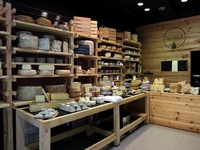 Elkano is outside San Sebastian in a small fishing village called Getaria. This year it was ranked number 30 in the 50 Best lists. It is the place to eat the best turbo in the world cooked as a whole fish on a charcoal grill just outside the restaurant next to its entrance. It’s served as a whole fish, the size depending on the people sharing it. For starters, try cod throats, red mullet, and small fresh peas if in season. Introduce yourself to the owner Aitor Arregui and congratulate him, pray for the soul of his late father, Pedro and say hello to Aitor’s son too. Ask them for live instructions on how to eat the turbo with your bare hands. The trouble is you’ll never enjoy turbo again elsewhere!
Elkano is outside San Sebastian in a small fishing village called Getaria. This year it was ranked number 30 in the 50 Best lists. It is the place to eat the best turbo in the world cooked as a whole fish on a charcoal grill just outside the restaurant next to its entrance. It’s served as a whole fish, the size depending on the people sharing it. For starters, try cod throats, red mullet, and small fresh peas if in season. Introduce yourself to the owner Aitor Arregui and congratulate him, pray for the soul of his late father, Pedro and say hello to Aitor’s son too. Ask them for live instructions on how to eat the turbo with your bare hands. The trouble is you’ll never enjoy turbo again elsewhere!
MARTIN BERASATEGUI
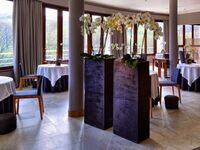
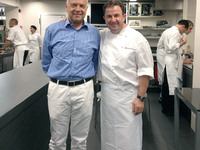 The fourth restaurant takes its name from its 50-year-old chef, Martin Berasategui. Its mesmerizing view of the forest makes it the perfect place to go for lunch. The restaurant is also quite modern and features a terrace during the summer. But it was perhaps Berasategui’s details that impressed me the most. For the first time ever, I saw packaged toothbrushes and toothpaste in the restroom – something that is very useful for customers. The waiters also speak English fluently, as well as many other languages.
The fourth restaurant takes its name from its 50-year-old chef, Martin Berasategui. Its mesmerizing view of the forest makes it the perfect place to go for lunch. The restaurant is also quite modern and features a terrace during the summer. But it was perhaps Berasategui’s details that impressed me the most. For the first time ever, I saw packaged toothbrushes and toothpaste in the restroom – something that is very useful for customers. The waiters also speak English fluently, as well as many other languages.
